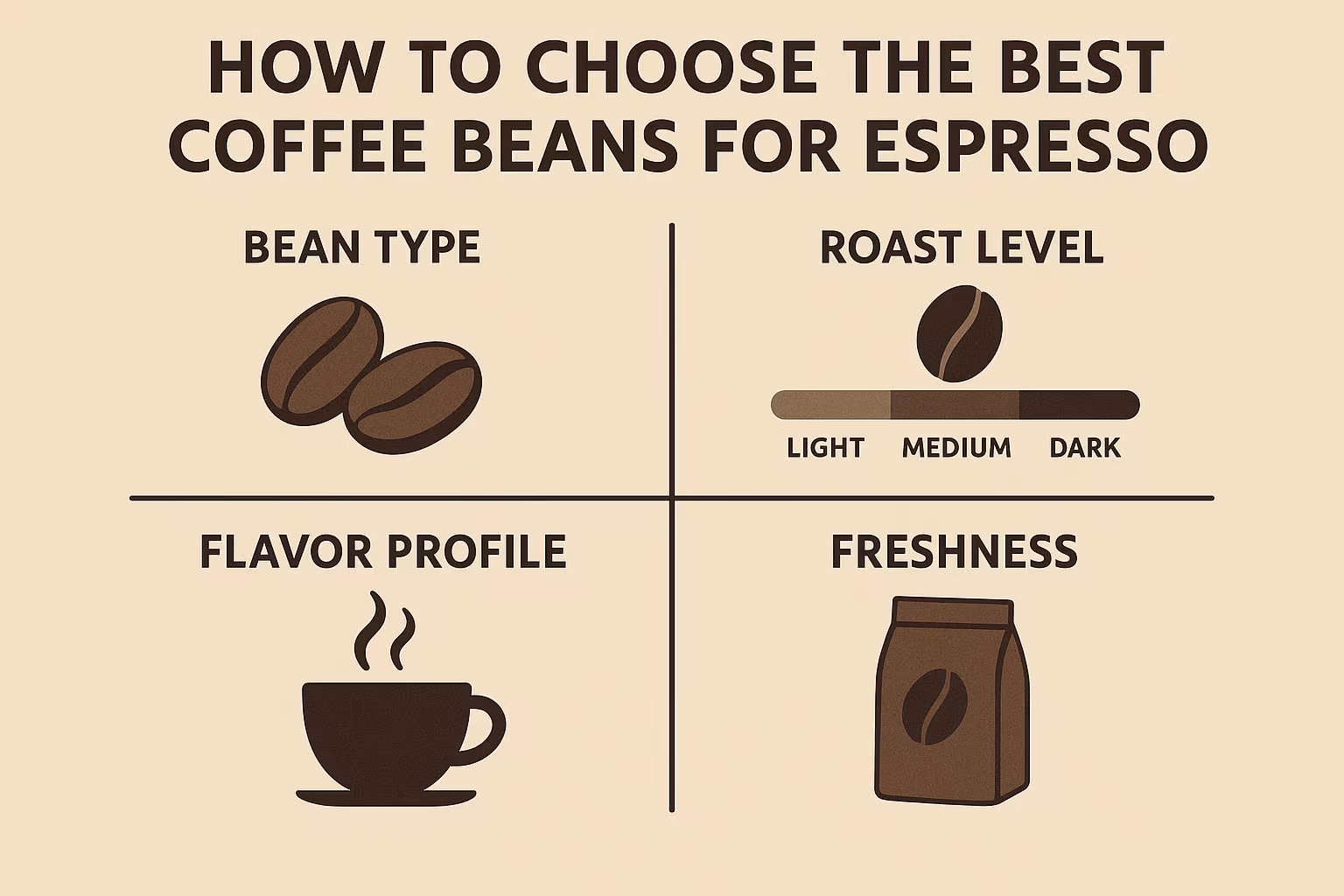Learn how to choose the best coffee beans for espresso with our expert guide. Discover roast types, flavor profiles, and barista-approved tips to select beans that deliver perfect crema, rich aroma, and balanced taste in every shot.
How to Choose the Best Coffee Beans for Espresso
Espresso is more than just a drink; it’s a ritual, an art form, and for many, the foundation of their morning routine. Knowing how to choose the best coffee beans for espresso can make the difference between a bitter, flat shot and a smooth, complex cup with golden crema. With thousands of options available in today’s coffee market—from Italian espresso traditions to modern third wave coffee innovations—the choice can feel overwhelming.
Choosing the Right Beans for Espresso: The Essentials
The first question coffee drinkers ask is straightforward: Which beans are best for espresso? The answer depends on bean variety, roast level, and freshness. According to the Specialty Coffee Association (SCA), espresso requires beans that balance body, acidity, and sweetness, but the specific choice comes down to preference and brewing style.
Arabica vs Robusta: Which Beans Work Best for Espresso?
Arabica: Known for smooth, complex flavors with floral or fruity notes. Common in specialty coffee roasters, Arabica beans dominate premium espresso blends. They contain less caffeine and less bitterness, making them ideal for nuanced flavors.
Robusta: Bolder and stronger, with earthy, nutty notes and twice the caffeine. Robusta is often used in traditional Italian blends to create a rich crema. Brands like Lavazza use Robusta in their classic espresso lines.
Blends: Many roasters combine Arabica and Robusta to balance complexity with body. A 70/30 blend is common in traditional European espresso bars.
Quote from Italian baristas: “Without Robusta, you lose the crema. Without Arabica, you lose the soul.” This simple phrase captures why blends remain popular.
Roast Level: Light, Medium, or Dark for Espresso?
Espresso is less about bean type and more about roast profile:
Light roast espresso: Highlights origin flavors such as citrus or floral notes, popular in third wave cafés like Blue Bottle or Stumptown.
Medium roast espresso: Balanced body and sweetness, often preferred by specialty roasters for its versatility.
Dark roast espresso: Classic Italian style, bold and chocolaty with low acidity. Favored by traditional brands like Illy.
| Roast Level | Flavor Notes | Best For |
|---|---|---|
| Light | Bright, fruity, floral | Specialty single-origin espresso |
| Medium | Balanced, sweet, nutty | Home espresso machines, all-rounder |
| Dark | Bold, smoky, chocolaty | Traditional Italian espresso lovers |
Freshness and Roast Date: Why It Matters
Freshness is crucial in espresso. Beans begin losing volatile aromatics within 2–3 weeks after roasting. Always check the roast date, not just the “best by” label. Specialty roasters like Verve Coffee and Sightglass emphasize roast dates to educate consumers. Stale beans result in flat shots, no matter how skilled the barista.
Understanding Espresso Flavor Profiles
Espresso is concentrated coffee, which means every detail of the bean shows up in the cup. Understanding flavor profiles helps you match beans to your preferences.
Balancing Acidity, Body, and Sweetness
Acidity: Not sourness, but a brightness that can resemble citrus or berries. Ethiopian Arabica beans often deliver high acidity.
Body: The texture or weight of the coffee. Brazilian beans often add heavy, syrupy body.
Sweetness: High-quality beans often bring caramel, chocolate, or fruit sweetness that balances bitterness.
Evidence: A study from the University of California, Davis (2023) confirmed that consumers consistently prefer espresso shots with a balance of medium acidity, high sweetness, and full body.
The Role of Crema in a Perfect Espresso Shot
Crema—the golden foam on top of espresso—is not just aesthetic. It carries aroma compounds and contributes to mouthfeel. Robustas produce thicker crema, which is why blends often include them. However, crema should be stable and velvety, not overly bubbly or dissipating quickly, a sign of stale or poor-quality beans.
See more: Top Specialty Coffee Roasters in California
Single-Origin vs. Blends: What’s Right for You?
Single-origin espresso: Offers a “pure” expression of a region. For example, Kenyan espresso brings wine-like acidity, while Colombian espresso highlights caramel and nutty sweetness.
Blends: Crafted for balance and consistency, blends ensure a stable flavor year-round despite seasonal variations. Most traditional Italian roasters use blends.
Analysis: Specialty cafés in California and New York increasingly promote single-origin espresso as an educational experience, while mainstream coffee houses continue with blends for customer familiarity.
Expert Tips for Buying Espresso Beans
Finding the right beans requires knowledge of sourcing, certifications, and brewing compatibility.
Where to Buy High-Quality Beans
Local specialty roasters: Freshness and transparency, plus the opportunity to connect with roasters directly.
Online subscriptions: Services like Trade Coffee deliver curated espresso beans from multiple roasters.
Trusted brands: Illy, Lavazza, and Verve are reliable options for consistent quality.
Recognizing Specialty Coffee and Certifications
Look for certifications that indicate quality and ethics:
SCA scoring: 80+ points = specialty grade.
Fair Trade/Direct Trade: Ethical sourcing models supporting farmers.
Organic certifications: Indicates environmentally friendly farming.
B Corp: Companies like Equator Coffees in California that meet rigorous social and environmental standards.
How Grind Size Impacts Flavor Extraction
Even with the best beans, a poor grind ruins espresso. Espresso requires a fine grind to achieve the right extraction in 25–30 seconds. Too coarse = sour and weak. Too fine = bitter and over-extracted. Investing in a burr grinder ensures consistency, which is as important as bean selection.
Proper Storage of Espresso Beans
Your job doesn’t end once you buy the beans. Storage directly affects taste and aroma.
Best Practices for Preserving Freshness
Airtight containers: Prevent oxygen exposure.
Cool, dark place: Avoid sunlight and heat.
Do not refrigerate: Condensation ruins beans.
Buy smaller batches: Consume within 2–3 weeks.
Mistakes to Avoid When Storing Coffee
Buying in bulk and letting beans sit for months.
Using transparent containers that expose beans to light.
Grinding all beans at once instead of grinding fresh.
Proverb: “Coffee is best like bread—fresh from the oven, not forgotten on the shelf.” This simple truth emphasizes why proper storage is as important as proper roasting.
Cultural Insights: The Art of Espresso
To truly understand how to choose the best coffee beans for espresso, one must also appreciate the cultural roots of espresso itself. Espresso was born in Italy in the early 20th century, when Angelo Moriondo patented the first espresso machine in Turin.
Since then, Italy has become synonymous with the drink. In Rome, Milan, and Naples, espresso is not merely consumed—it is celebrated as a daily ritual. Italians traditionally favor dark roasted blends with Robusta because they value strong body and crema over nuanced flavors.
This tradition still influences many global coffee brands such as Illy and Lavazza.
Yet, the rise of third wave coffee in California, New York, and beyond has shifted perceptions. Here, baristas experiment with lighter roasts and single-origin beans, extracting citrusy or floral notes that would surprise a traditional Italian drinker. The contrast illustrates how culture shapes bean choice. What is “best” depends on whether you seek tradition or innovation.
Italian Espresso Traditions and Global Influence
Italian espresso is defined by rules—served in small porcelain cups, consumed quickly while standing at the bar, often without milk. Beans are roasted darker to deliver consistency across cafés. By contrast, American specialty roasters have redefined espresso as a platform for exploration, using Ethiopian, Kenyan, or Colombian single origins to create shots that taste of berries, jasmine, or even wine. Both traditions have merit. As a famous saying goes, “When in Rome, do as the Romans do.” But when in California, expect espresso to taste like no other.
The Rise of Third Wave Coffee and Espresso Innovation
California has become a global pioneer in espresso innovation. Roasters such as Blue Bottle, Verve, and Equator approach espresso like fine dining: traceable sourcing, seasonal menus, and educational experiences. At events like the Los Angeles Coffee Festival, cupping tables are filled with beans showcasing fermentation experiments—anaerobic, honey-processed, or carbonic maceration that result in flavors once thought impossible in espresso.
According to the Specialty Coffee Association’s 2024 report, third wave roasters have boosted consumer demand for lighter espresso roasts by 40% in the U.S. This shows how innovation, once niche, is now mainstream.
Inspirational Narratives and Stories
No article about espresso beans is complete without stories that humanize the process. Farmers in Ethiopia often describe coffee as “the gift of the land.” In Colombia, families pass down coffee farms for generations, teaching younger members not only how to cultivate beans but also how to preserve soil and biodiversity. These narratives matter because when you choose beans, you choose the livelihood of these communities.
Consider this anecdote: At a cupping session in San Francisco, a Guatemalan farmer told attendees how direct trade with a California roaster allowed his village to build a new school. That single partnership transformed education access for dozens of children. Stories like this embody the CANABIS method’s Inspiration and Storytelling elements—reminding us that every sip of espresso connects us to someone else’s story thousands of miles away.
Evidence and Analysis: Why Bean Choice Matters
Scientific evidence supports why choosing the right beans is critical.
A 2023 study from UC Davis confirmed that bean freshness contributes up to 70% of perceived flavor quality in espresso.
Research published in Food Chemistry (2022) showed that Arabica beans contain nearly twice as many aromatic compounds as Robusta, explaining their complexity.
Market data from Statista revealed that U.S. specialty coffee consumption rose by 14% year-over-year in 2024, with espresso being the fastest-growing segment.
Analysis: These findings prove that consumer demand aligns with quality. People are not just drinking espresso for caffeine; they are seeking experience, flavor, and ethical value. By investing in specialty beans, you participate in a movement that prioritizes taste, sustainability, and fairness.
Practical Tips for Everyday Espresso Lovers
Here is a concise checklist to apply when buying beans:
Check the roast date: Fresh is best—ideally consumed within 2–3 weeks.
Match roast to taste: Light for bright and fruity, medium for balance, dark for bold and traditional.
Experiment with origins: Ethiopian for citrus, Colombian for caramel, Brazilian for chocolate.
Choose blends for consistency: Especially if you drink espresso daily and prefer stability.
Support local roasters: Builds community and ensures transparency.
Proverb: “The best time to plant a tree was 20 years ago. The second-best time is now.” The same applies to your espresso journey—the sooner you start exploring quality beans, the richer your experience will become.
Conclusion: How to Choose the Best Coffee Beans for Espresso
Learning how to choose the best coffee beans for espresso is not just a technical decision—it is a lifestyle choice. From understanding the difference between Arabica and Robusta to recognizing the impact of roast levels, freshness, and single-origin versus blends, your choice defines your daily ritual.

My name is Kara Chavez, and I love coffee. I love making the best coffees – espresso, latte, macchiato. I always strive for perfection in my barista skills, and I take great pride in bringing delicious cups of coffee to my customers.
I’ve been in the coffee industry for many years, and I know everything there is to know about brewing the perfect cup of coffee. My passion for coffee shines through in every cup I make, and I hope you’ll stop by soon so I can share my love of coffee with you!

